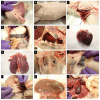Characterization of an African Swine Fever Virus Field Isolate from Vietnam with Deletions in the Left Variable Multigene Family Region
- PMID: 38675912
- PMCID: PMC11054794
- DOI: 10.3390/v16040571
Characterization of an African Swine Fever Virus Field Isolate from Vietnam with Deletions in the Left Variable Multigene Family Region
Abstract
In this paper, we report the characterization of a genetically modified live-attenuated African swine fever virus (ASFV) field strain isolated from Vietnam. The isolate, ASFV-GUS-Vietnam, belongs to p72 genotype II, has six multi-gene family (MGF) genes deleted, and an Escherichia coli GusA gene (GUS) inserted. When six 6-8-week-old pigs were inoculated with ASFV-GUS-Vietnam oro-nasally (2 × 105 TCID50/pig), they developed viremia, mild fever, lethargy, and inappetence, and shed the virus in their oral and nasal secretions and feces. One of the pigs developed severe clinical signs and was euthanized 12 days post-infection, while the remaining five pigs recovered. When ASFV-GUS-Vietnam was inoculated intramuscularly (2 × 103 TCID50/pig) into four 6-8 weeks old pigs, they also developed viremia, mild fever, lethargy, inappetence, and shed the virus in their oral and nasal secretions and feces. Two contact pigs housed together with the four intramuscularly inoculated pigs, started to develop fever, viremia, loss of appetite, and lethargy 12 days post-contact, confirming horizontal transmission of ASFV-GUS-Vietnam. One of the contact pigs died of ASF on day 23 post-contact, while the other one recovered. The pigs that survived the exposure to ASFV-GUS-Vietnam via the mucosal or parenteral route were fully protected against the highly virulent ASFV Georgia 2007/1 challenge. This study showed that ASFV-GUS-Vietnam field isolate is able to induce complete protection in the majority of the pigs against highly virulent homologous ASFV challenge, but has the potential for horizontal transmission, and can be fatal in some animals. This study highlights the need for proper monitoring and surveillance when ASFV live-attenuated virus-based vaccines are used in the field for ASF control in endemic countries.
Keywords: African swine fever; GUS; MGF; horizontal transmission; live-attenuated virus; virulence.
Conflict of interest statement
The authors declare no conflict of interest.
Figures











References
-
- Swine Disease Global Surveillance Report, 7 November–4 December 2023. [(accessed on 6 February 2024)]. Available online: https://www.swinehealth.org/wp-content/uploads/2023/12/December-Report.pdf.
-
- USDA Statement on Confirmation of African Swine Fever in Haiti. 21 September 2021. [(accessed on 6 August 2023)]; Available online: https://www.aphis.usda.gov/aphis/newsroom/stakeholder-info/sa_by_date/sa....
Publication types
MeSH terms
Grants and funding
LinkOut - more resources
Full Text Sources

